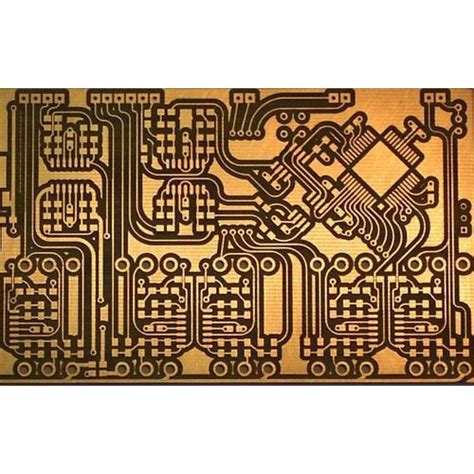Types of metals used in PCB
Copper
Copper is the most commonly used metal in PCB fabrication due to its excellent electrical conductivity, thermal conductivity, and durability. It is used for creating the conductive traces, pads, and vias on the PCB. Copper is also relatively inexpensive compared to other metals with similar properties.
Advantages of using copper in PCB:
- High electrical conductivity
- Good thermal conductivity
- Durability and resistance to corrosion
- Cost-effective
Disadvantages of using copper in PCB:
- Susceptible to oxidation
- Requires additional surface finishes for protection
Gold
Gold is another metal used in PCB manufacturing, particularly for high-end applications that require superior conductivity and corrosion resistance. Gold is often used as a surface finish for contact pads and connectors, as it provides excellent electrical conductivity and resistance to oxidation.
Advantages of using gold in PCB:
- Excellent electrical conductivity
- High resistance to oxidation and corrosion
- Suitable for high-frequency applications
- Biocompatible and suitable for medical devices
Disadvantages of using gold in PCB:
- Expensive compared to other metals
- Soft and prone to wear
Silver
Silver is sometimes used in PCB fabrication as an alternative to gold, particularly in high-frequency applications. It offers excellent electrical conductivity and is less expensive than gold.
Advantages of using silver in PCB:
- High electrical conductivity
- Lower cost compared to gold
- Suitable for high-frequency applications
Disadvantages of using silver in PCB:
- Prone to oxidation and tarnishing
- Requires additional surface finishes for protection
Aluminum
Aluminum is occasionally used in PCB manufacturing for its good thermal conductivity and lightweight properties. It is often used as a substrate material for PCBs in applications that require efficient heat dissipation, such as power electronics and LED lighting.
Advantages of using aluminum in PCB:
- Good thermal conductivity
- Lightweight
- Cost-effective compared to other metals with similar thermal properties
Disadvantages of using aluminum in PCB:
- Lower electrical conductivity compared to copper
- Requires special processing techniques
PCB Surface Finishes
Surface finishes are applied to the exposed copper traces and pads on a PCB to protect them from oxidation, corrosion, and wear. The choice of surface finish depends on the specific application, environmental conditions, and cost considerations. Some common PCB surface finishes include:
- HASL (Hot Air Solder Leveling)
- ENIG (Electroless Nickel Immersion Gold)
- OSP (Organic Solderability Preservative)
- Immersion Silver
- Immersion Tin
| Surface Finish | Advantages | Disadvantages |
|---|---|---|
| HASL | – Cost-effective – Good solderability |
– Uneven surface – Not suitable for fine-pitch components |
| ENIG | – Flat surface – Good corrosion resistance – Suitable for fine-pitch components |
– Expensive – Risk of “black pad” defect |
| OSP | – Cost-effective – Flat surface – Easy to apply |
– Limited shelf life – Not suitable for multiple reflow cycles |
| Immersion Silver | – Good solderability – Suitable for fine-pitch components |
– Prone to tarnishing – Requires careful handling |
| Immersion Tin | – Good solderability – Suitable for fine-pitch components |
– Prone to whisker formation – Limited shelf life |
Choosing the right metal for your PCB
When selecting the metal for your PCB, consider the following factors:
- Electrical requirements: Choose a metal with the appropriate electrical conductivity for your application.
- Thermal requirements: If your application generates significant heat, consider a metal with good thermal conductivity, such as aluminum or copper.
- Environmental conditions: Consider the operating environment of your device and choose a metal and surface finish that can withstand the expected conditions, such as humidity, temperature, and corrosive substances.
- Cost: Balance the performance requirements with the cost of the metal and surface finish.
- Manufacturing process: Ensure that the chosen metal and surface finish are compatible with your PCB manufacturing process and the components used in your device.

FAQ
1. What is the most common metal used in PCB fabrication?
Copper is the most common metal used in PCB fabrication due to its excellent electrical conductivity, thermal conductivity, and cost-effectiveness.
2. Why is gold used in PCB manufacturing?
Gold is used in PCB manufacturing for high-end applications that require superior conductivity and corrosion resistance. It is often used as a surface finish for contact pads and connectors.
3. What are PCB surface finishes, and why are they important?
PCB surface finishes are applied to the exposed copper traces and pads on a PCB to protect them from oxidation, corrosion, and wear. They ensure the reliability and longevity of the PCB and its components.
4. Can aluminum be used as a substrate material for PCBs?
Yes, aluminum can be used as a substrate material for PCBs in applications that require efficient heat dissipation, such as power electronics and LED lighting.
5. What factors should be considered when choosing the metal for a PCB?
When choosing the metal for a PCB, consider the electrical and thermal requirements, environmental conditions, cost, and compatibility with the manufacturing process and components used in the device.
Conclusion
The choice of metal used in PCB fabrication is crucial for ensuring the reliability, durability, and performance of electronic devices. Copper is the most commonly used metal due to its excellent electrical and thermal properties, as well as its cost-effectiveness. Other metals, such as gold, silver, and aluminum, are used in specific applications that require superior conductivity, corrosion resistance, or thermal management.
PCB surface finishes play a vital role in protecting the exposed metal traces and pads from oxidation, corrosion, and wear. The selection of the appropriate surface finish depends on the specific application, environmental conditions, and cost considerations.
When designing a PCB, it is essential to consider the electrical and thermal requirements, environmental conditions, cost, and manufacturing process to choose the most suitable metal and surface finish for your application. By making informed decisions about the materials used in your PCB, you can ensure the optimal performance and longevity of your electronic device.

No responses yet